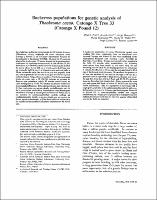| dc.contributor.author | Fritz, Paul. J | |
| dc.contributor.author | Osei, Joseph | |
| dc.contributor.author | Morera, Jorge | |
| dc.contributor.author | Rodríguez, Helga | |
| dc.contributor.author | Walker, David. R | |
| dc.contributor.author | Laínez, Jorge | |
| dc.contributor.author | Lastra, Ramón | |
| dc.date.accessioned | 2020-08-20T21:27:52Z | |
| dc.date.available | 2020-08-20T21:27:52Z | |
| dc.date.issued | 1995-01 | |
| dc.identifier.uri | https://repositorio.catie.ac.cr/handle/11554/9495 | |
| dc.description.abstract | Se estudió una población retrocruzada de 165 árboles de cacao (Theobroma cacao), originada del cruce interclonal entre Catongo y Pound 12, en el Centro Agronómico Tropical de Investigación y Enseñanza (CATIE). Después de 27 meses de plantación en el campo (33 meses después de la germinación), se hicieron las siguientes observaciones: a) 116 árboles (70.3 porciento) florecieron y 34 (20.6 porciento) árboles tuvieron mazorcas; b) el árbol de mayor altura fue de 168 cm y el más corto de 24 cm, con un promedio de 95.6 cm; c) el diámetro más ancho de tallo, a 30 cm encima del suelo, fue de 6.5 cm y el más pequeño a 0.8 cm, con un promedio de 4.0 cm; d) un gen de color se expresó en los brotes de follaje, flores y semillas: 75 árboles mostraron brotes de color rojo y 59 (78.7 porciento) estaban en proceso de florecer (con estambres rojos); 87 árboles tenían brotes de color verde pálido y 57 (65.5 por ciento) estaban en proceso de florecer (con estambres blancos). Esta segregación con una relación de 1:1 fue consistente con un gen simple, probablemente por vía de la antocianina biosintética, denotándose como homocigota recesivo en Catongo y homocigota dominante en Pound 12; e) los estudios de autocompatibilidad también indican un condicionamiento debido a un gen simple que se expresa en forma recesiva-dominante; y f) los datos sobre las mazorcas y las semillas correspondieron al primer cuatrimestre del tercer año. | es_ES |
| dc.description.abstract | A backcross population totalling 165 trees, originating from an intraclonal cross between Catongo and Pound 12, was established in Turrialba, Costa Rica. These observations were made 27 months after planting in the field (33 months after germination): 116 trees (70.3 percent) were flowering and 34 (20.6 percent) were bearing pods; the tallest tree was 168 cm, the shortest 24 cm and the mean height 95.6 cm; the largest trunk diameter 30 cm above the ground was 6.5 cm, the smallest 0.8 cm and the average 4 cm; a gene for colour was expressed in flush leaves, flowers and seeds. As 75 trees gave red leaf flush and 59 of these were flowering (red staminodes), while 87 gave pale green leaf flush, with 57 flowering (white staminodes), the 1:1 segregation appeared consistent with a single gene, probably in the anthocyanin synthesis pathway, which was homozygous recessive in Catongo and homozygous dominant in Pound 12. Pod and seed data for the first quarter of the third year are reported. | |
| dc.format.mimetype | pdf | |
| dc.language.iso | es | es_ES |
| dc.publisher | IICA, San José (Costa Rica) | es_ES |
| dc.relation.ispartof | Turrialba; Volumen 45, Número 1 | es_ES |
| dc.rights | info:eu-repo/semantics/openAccess | es_ES |
| dc.rights.uri | https://creativecommons.org/licenses/by-nc-nd/4.0/ | |
| dc.subject | THEOBROMA CACAO | |
| dc.subject | HÍBRIDOS | |
| dc.subject | VARIEDADES | |
| dc.subject | FITOMEJORAMIENTO | |
| dc.subject | HOJAS | |
| dc.subject | FRUTO | |
| dc.subject | COLOR | |
| dc.subject | ALTURA | |
| dc.subject | DIÁMETRO | |
| dc.subject | ETAPAS DE DESARROLLO DE LA PLANTA | |
| dc.subject | COSTA RICA | |
| dc.title | Backcross populations for genetic analysis of Theobroma cacao. Catongo X Tree 33 (Catongo X Pound 12) | es_ES |
| dc.type | Artículo | es_ES |
| dc.journal.volume | 45 | |
| dc.journal.issueNumber | 1-2 | |
| dc.journal.pages | 49-56 | |



